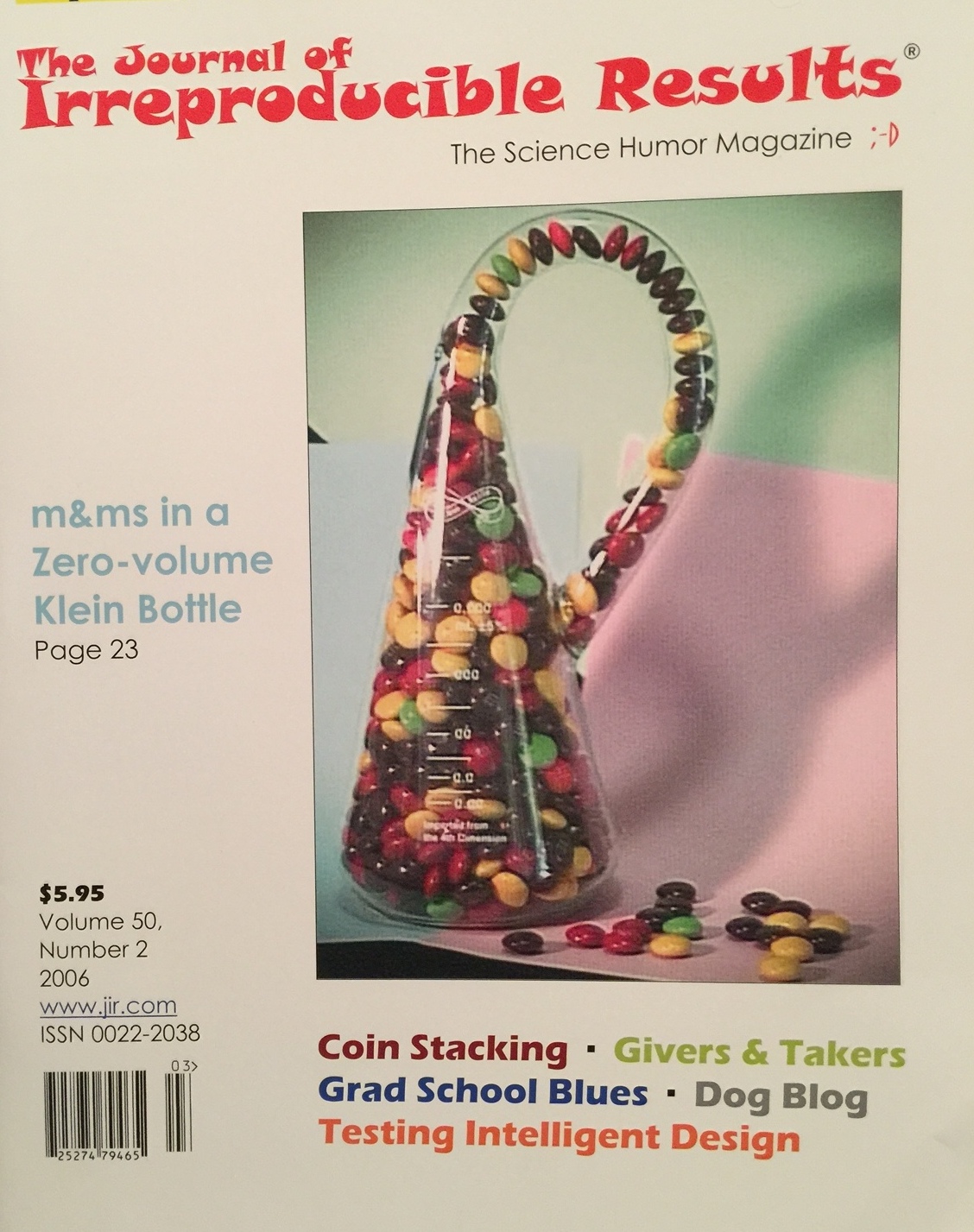
Here is my article published in February 2006, Volume 50, number 2, in the esteemed print periodical Journal of Irreproducible Results.

“Construction with Copper Disks”
I held a scrap of paper in my hand with the address scribbled on it. “Floor 42 apartment 12, Tokyo Towers South”. I took a deep breath and knocked. Being a freelance journalist I never know how these cold calls will turn out. I had come to Tokyo last year on a hot story and stayed. Now my ideas for stories were drying up and I had bills to pay. One good story for an inflight magazine would pay last month’s rent.
An elderly Japanese man with white hair answered the door and said, “You are the reporter?”
“Yes, and you are Dr. Fujitsu of Tokyo University?”
“Yes, yes. Come in.” he said quickly in excellent English.
I entered his small, cramped apartment and noticed the framed photographs of various buildings clinging to the walls. Dr. Fujitsu had designed four skyscrapers in Japan, one in Paris and two in L.A. Before he had retired to teaching, he was the in-demand architect of Japan.
He motioned me over to his dining table by a window.
I had to wade through the clutter, stepping over a scale model of a traditional Japanese pagoda on the way. The view of the skyline was breathtaking. I knew now why a man of his stature would live in this cramped apartment
“Tea?” he asked.
I took the tea to be polite and slurped the best I could.
“You are here about my amazing new idea?” he asked.
I assured him I was, although a little fuzzy on what the idea was. A friend had given me his name.
“My grand idea came to me during an earthquake”, Dr. Fujitsu said eagerly. “During the quake I was surfing the web and viewing a site on coin stacking – a craze that started here in Japan, of course, and has swept over the world. The coin structures are built using only the weight of the coins to cantilever coins over open space, no adhesive is used. That’s when it hit me – I could design earthquake-proof structures from huge copper disks! I was shocked no one had thought of this before.”
“For example,” Dr. Fujitsu said showing me the following photo, “Bridges built like these would be earthquake proof because the coins just slide over each other during a quake.”
Photo by Sarah Fincher
“So you want to scale these structures up to cross rivers?” I asked hesitantly.
“Yes, yes, of course.” he said somewhat irritated that I was so dense.
“And this picture shows a design that can be used for long spans” he continued unfazed.
Photo by Mike Peden of Dripping Springs Texas
“I am going to change the way buildings are made and make a mint in the process. For example, this tower will be a high-rise apartment building. Each flat will be its own self-contained prefab hollow disk with plumbing routed above and below on flexible tubes to the neighbors – windows all around the edges of course. With prefab construction we have a solution to the Japanese housing shortage! We can stack these earthquake-proof structures to the sky” Dr. Fujitsu babbled.
Photo by John Sterling from Sweden
“Our nuclear power plants will be much safer with cooling towers made like these” he said, again sliding a glossy photo my way.
Photo by Ben Kiefer
More tea?” he asked.
I declined and looked at my watch. This hot tip I’d received from a friend about a genius architect seemed a little tarnished now.
“No longer will earthquakes take a toll on our country.” he said.
“Well how exactly does this work?” I asked.
“Only the weight of the upper units holds the bottom ones in place. The friction between the coins is the coefficient of friction times the weight of the disks above. The upper ones will sway, dissipating the energy of the earthquake with their friction. The structures will be flexible like bamboo, so they will survive the earthquakes. Afterwards, hydraulic jacks will be used to nudge the units back to their correct place. This is much cheaper than repairing the twisted steel frames of traditional structures.”
He continued, “And with dome structures we can have sporting events hosted inside multi-story earthquake buildings.”
Photo by Mike Peden of Dripping Springs Texas
Dr. Fujitsu continued to talk and showed the following photos saying that he could design office towers like these.
Photo by Jeff Preshing of Montreal, Canada
Photo by Todd Kettering of Austin, Texas
Photo by Steinar of Norway
Photo by Rick Einhorn
Photo by Peder A Olsen of Tonsberg, Norway
“Of course” Dr. Fujitsu said, “the whole world will go to my new method – it’s only common sense.”
I was sure by now that the good doctor was a few fries short of a happy meal. Not wanting to leave hurriedly, I asked what he wanted to do with the rest of his life.
“I have a yen to leave my mark on the world.” he said frankly.
I thanked him for his time, put my tea cup down and excused myself.
Leaving the building I entered the crowded street. The ground began to shake. I almost yelled in fright. The girders in the building above me groaned and a window shattered, but the crowd just swayed gently with the earth unaffected and continued on their way unconcerned.
I thought to myself, “Maybe Dr. Fujitsu is right and Japanese architecture is ready for change.”
Reported by Mitch Fincher. All photos from www.CoinStacking.com.